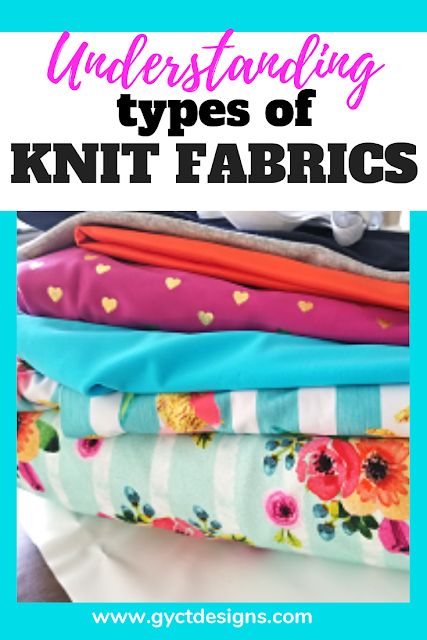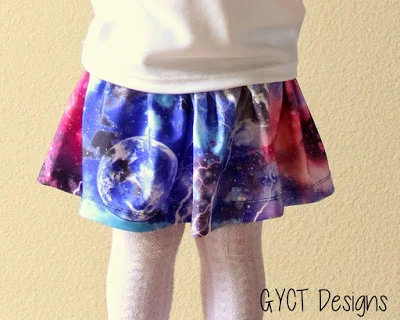A lot of people have fear of knit fabrics. You know, those stretchy fabrics used to make your favorite t-shirt.
WHY?
Maybe because they stretch. Maybe because grandma never taught you how to sew on knit. Or maybe, it's just because you haven't taken the leap and tried and they seem like they'll be difficult.
*This post contains affiliate links to products I have used and highly recommend. I do make a portion off any you may purchase. But I wouldn't link to them if they weren't awesome! See full disclosure here.
Let me tell you, there is NOTHING to be afraid of. Knit fabrics are so easy to sew and your creations will come out AMAZING. I promise once you start sewing with knits you'll never go back.
Today we are going to talk about the most important step in sewing with knit fabrics. Choosing the right type of knit fabric.
When deciding on a knit project you first need to make the correct choice of what type of knit fabric to choose. Not all knits are the same. And not all knits are created equal. The weight of the knit fabric, the stretch of the fabric and how you plan to use the fabric will make a difference for each project. That may sound like a lot to learn, but it is actually really easy.
So here is a little beginners guide to choosing and using the most common types of knit fabrics.
To start, we need to understand knit fabric content and weight. These two things will ad you in your quest to find the perfect knit fabric for your sewing project.
Fabric Content
To start, make sure you look at the fabric content of your knit fabrics at the store. Remember the part where I said "not all knits are the same".A knit fabric that contains lycra or spandex is going to have more stretch than one that does not. So you may have a Jersey knit that has more stretch than an Interlock.
However, it still may not be the right weight for the project you are planning. Reading those fabric content labels on the side of your fabric bolt or online is super important.
Looking to purchase knit fabrics? Check out our list of the best places to purchase knit fabrics.
Fabric Weight
Knit fabric weight does make a difference. You will be very disappointed if you purchase a lightweight knit to make a t-shirt. Or if you get a heavyweight knit for a summer dress. Understanding knit fabric weight matters.Lightweight = 6.5oz or less
Lightweight fabrics are going to be very light and fairly see through. These are great for lining or to be layered with other knits, but not as a stand alone knit.
Light to Medium Weight = 7-9oz
These knits are going to be fairly see through still, but dark colors can be worn alone. It is wise to layer light to medium knit fabrics. They also work great for accessories like scarves and baby stocking caps.
Medium Weight = 9.5-11.5oz
Medium weight knits are perfect for most knit sewing projects. They have a great drape and work well in warm and cool weather.
Medium to Heavy Weight = 12-14oz
These are the knits great for outer wear, leggings, t-shirts and dresses. They won't have as much drape, but they are great for cool weather sewing projects that may use french terry or light sweatshirt fleece.
Heavy Weight = 15oz or more
Heavy knits usually have a lot less stretch so they are not as common to find. Heavy weight knits include sweatshirt fleeces with very little to no stretch to them.
You can most often find the weight of a fabric on the end of the fabric bolt or in the fabric description online. Make sure you read!! Spending $15 for a yard of knit you will never use will frustrate you.
Understanding Types of Knit Fabric
Jersey KnitsJersey knit is a type of knit fabric that may have very little stretch to a lot of stretch depending on fiber content. They also vary in weight, meaning they can be very lightweight, or almost see through, to heavy weight. Making sure you have a clear understanding of the stretch and weight of knit fabric you'll need for your project does matter.
Jersey knits tend have a very soft and smooth surface. The most common use for Jersey knits are for tops and t-shirts. They do have great drape so are perfect for dresses or flowy tops. Just check the thickness first.


Interlock Fabrics
Medium Stretch



Rival Raglan in Interlock and Jean and Jamey Jammies in Interlock and Sleepyhead Nightgown
Ponte Knit Fabrics
| Small amount of stretch |
Ponte knits are a double knit fabric which means they tend to be heavier weight. They do not have much stretch unless combined with a lycra fiber. Ponte knits are sturdy and great for skirts, cardigans or jackets. They work for tops like a t-shirts.
I have found they tend to pill more in washing, meaning they get little fuzzy balls on them after so many washes. So you may need to handwash or just wash and lay flat to dry.



Rival Raglan in ponte and and Tinley Tee
Rib Knit
Rib knits are a type of knit fabric that have great stretch and recovery. They are the most common knit used for neckbands and cuffs on t-shirts.Cotton Lycra
Cotton Lycra is a 4-way stretch knit fabric. This means that no matter which direction you pull, it will stretch. Lycra fabrics are great for layering. Lycra fabrics are perfect for sewing leggings, skirts and flowy tops.
Nylon Spandex
Nylon Spandex knit is most commonly used in swimwear and dancewear. Nylon Spandex has a 4 way stretch which allows for great stretch and recovery. And because it is a synthetic fiber, it is designed to withstand the moisture and chemicals from swimming pools.
Fleece (Polar)
Another fabric that is brought up a lot when talking about knit fabrics is fleece. It is comfy and cozy and kids LOVE the feel of it. The biggest downfall for fleece, when it comes to sewing knits, is stretch. Fleece has very little stretch. Which means it is not an ideal choice for sewing a top that needs to stretch over a head. However, fleece is great for jackets or sweaters with large necklines.
| Denali Fleece Jacket |
There you have the most common types of knit fabric. If you are interested in learning more about sewing with knit fabrics? Enroll in our free course















